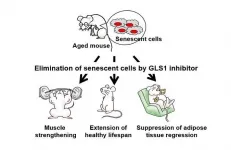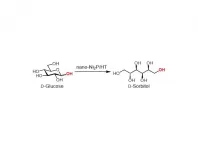(Press-News.org) Senescent cells accumulate in organs during aging, promote tissue dysfunction, and cause numerous aging-related diseases like cancer. The cells arise through a process called "cellular senescence," a permanent cell cycle arrest resulting from multiple stresses.
A collaborative research group led by Professor Makoto Nakanishi of the Institute of Medical Science, The University of Tokyo (IMSUT), and co-researchers has identified an inhibitor of the glutamate metabolic enzyme GLS1(*1) so that its administration selectively eliminates senescent cells in vivo. They confirmed that the GLS1 inhibitor eliminated senescent cells from various organs and tissues in aged mice, ameliorating age-associated tissue dysfunction and the symptoms of obese diabetes, arteriosclerosis, and NASH. The results of this research were published in "Science" on January 15, 2021.
Previous studies have shown that genetically engineering removal of senescent cells from aged mice delays the onset of geriatric diseases such as arteriosclerosis and renal damage and extends the healthy life expectancy. However, those studies have not led to identifying useful drug candidates.
Professor Nakanishi said," Our results can contribute to the development of new anti-aging therapies that remove senescent cells by targeting these cells' metabolic characteristics.".
Lysosomal membranes hold the key to senescent cell removal
The research team has developed a new method for producing purified senescent cells to search for genes essential for senescent cells' survival. This new method activates the p53 gene in the G2 phase, which can efficiently induce cellular senescence.
They used purified senescent cells to search for genes essential for senescent cells' survival, then identified GLS1, which is involved in glutamine metabolism, as a potential candidate gene.
When they examined the effect of GLS1 inhibitor on the mortality of senescent cells, senescent cells were more sensitive to GLS1 inhibition due to damage to the lysosomal membrane and decreased intracellular pH. When they administered GLS1 inhibitors to aged mice, senescent cells in various tissues and organs were removed, and the aging phenomenon was significantly improved.
Organelles called lysosomes(*2) play an essential role in the regulation of intracellular pH. The team analyzed the dynamics of lysosomes and found the vital fact that damage to the lysosomal membranes in senescent cells lowers intracellular pH.
For details of the research, please see the paper.
Expectations for innovative anti-aging therapies and treatments for geriatric diseases
The results of this study show more interesting results. As aging progresses, motor function declines due to muscle loss, and metabolic disorders due to adipose tissue atrophy occur. But, when the research team injected GLS1 inhibitors into mice suffering age-related disorders, the progression of these age-related symptoms was suppressed. Moreover, GLS1 inhibitors were able to relieve the symptoms of obese diabetes, arteriosclerosis, and NASH(*3).
According to the team, GLS1 inhibitors are currently in clinical trials as effective cancer treatments. "We hope that innovative anti-aging therapies and treatments for geriatric diseases will be developed that can remove senescent cells by treatment with GLS1 inhibitors," said Professor Nakanishi.
INFORMATION:
Co-researches
Keiichi Nakayama (Professor, Department of Molecular and Cellular Biology, Medical Institute of Bioregulation, Kyushu University)
Masaki Matsumoto (Professor?Department of Omics and Systems Biology?Niigata University)
Makoto Suematsu (Professor, Department of Biochemistry, Keio University School of Medicine)
Yuki Sugiura (Assistant Professor, Department of Biochemistry, Keio University School of Medicine)
Makoto Arita (Team leader, Laboratory for Metabolomics, RIKEN Center for Integrative Medical Sciences)
Masataka Sugimoto (Director, Research Institute, National Center for Geriatrics and Gerontology)
Research Notes
(*1) GLS1
Abbreviation for glutaminase 1. A type of amidohydrolase enzyme that produces glutamic acid and ammonia from glutamine.
(*2) Lysosomes
One of the membrane-enclosed organelles of eukaryotes. The lumen of lysosomes is acidified to around pH 5 and contains hydrolases, allowing the organelle to perform intracellular digestion.
(*3) NASH
A disease in which fat accumulates in the liver in an alcohol-independent manner, causing inflammation and fibrosis. As it progresses, it causes cirrhosis and liver cancer.
While scientists and historians have long surmised that etchings on stones and bones have been used as a form of symbolism dating back as early as the Middle Paleolithic period (250,000-45,000 BCE), findings to support that theory are extremely rare.
A recent discovery by archeologists from the Hebrew University and the University of Haifa alongside a team from the Le Centre National de la Recherche Scientifique in France have uncovered evidence of what may be the earliest-known use of symbols. The symbols were found on a bone fragment in the Ramle region in central ...
A City of Hope-led research team found that the same gene that increases the risk for Alzheimer's disease, ApoE4, can increase the susceptibility to and severity of COVID-19.
"Our study provides a causal link between the Alzheimer's disease risk factor ApoE4 and COVID-19 and explains why some (e.g., ApoE4 carriers) but not all COVID-19 patients exhibit neurological manifestations" said Yanhong Shi, Ph.D., director of the Division of Stem Cell Biology at City of Hope and co-corresponding author of the new study. "Understanding how risk factors for neurodegenerative diseases ...
The distinctive gut microbiome profile of a person with liver cancer linked to non-alcoholic fatty liver disease (NAFLD) could be the key to predicting someone's risk of developing the cancer, say researchers from the UNSW Microbiome Research Centre (MRC).
Their new study, published in Nature Communications recently, found the gut microbiome - the kingdom of microorganisms living in our digestive tracts - can modulate the immune response in liver cancer patients with NAFLD, in a way that promotes the cancer's survival.
While the research is still in its early stages, this finding could lead to more effective preventative and therapeutic treatments for people at risk of developing NAFLD-related liver ...
The intestine harbors the largest number of immune cells in our body. Since the intestine is constantly exposed to various antigens like bacteria and food, appropriate induction of gut immune cells plays a pivotal role in gut homeostasis.
A POSTECH research team - led by Professor Seung-Woo Lee, Ph.D. candidate Sookjin Moon and research assistant professor Yunji Park of the Department of Life Sciences - has uncovered for the first the mechanism for regulating the differentiation of T cells (intraepithelial lymphocyte, IEL) via intestinal epithelial cells (IEC). These findings were recently published in the Journal of Experimental Medicine ...
Cells replicate their genetic material and divide into two identical clones, perpetuating life -- until they don't. Some cells pause -- or are intentionally made to pause -- in the process. When the cell resumes division after such a pause, a displaced nucleus -- an essential part of cell survival -- can become caught in the fissure, splitting violently and killing both cells. But that is not always the case; some mutant cells can recover by pushing their nucleus to safety. Researchers from Hiroshima University in Japan are starting to understand how in the first step toward potential cell death rescue applications.
The results were published on Jan. 22 in iScience, a Cell Press journal.
The researchers examined fission yeast, a common model organism ...
This is the finding of an 18-year-study of over 300,000 people with diabetes in England, from scientists from Imperial College London and published in the journal The Lancet Diabetes & Endocrinology.
Thursday Feb 4th is World Cancer Day.
The research, funded by the Wellcome Trust, reveals that between 2001-2018 heart disease and stroke were no longer the leading causes of death among people with diabetes, as they were 18 years ago.
Diabetes affects 4.7 million people in the UK, and is caused by the body being unable to regulate blood sugar levels. Around 90 per cent have type ...
Osaka - Many different catalysts that promote the conversion of glucose to sorbitol have been studied; however, most offer certain properties while requiring compromises on others. Now, researchers from Osaka University have reported a hydrotalcite-supported nickel phosphide nanoparticle catalyst (nano-Ni2P/HT) that ticks all the boxes. Their findings are published in Green Chemistry.
Sorbitol is a versatile molecule that is widely used in the food, cosmetics, and pharmaceuticals industries. There is therefore a pressing need to produce sorbitol in a sustainable, low-cost, and green manner.
The nickel catalysts that are commonly used in the industrial hydrogenation of glucose to sorbitol are unstable in air and require hash reaction conditions. Rare metal alternatives--despite being ...
Remember the first rule of fight club? That's right: You don't talk about fight club. Luckily, the rules of Hollywood don't apply to science. In new published research, University of Arizona researchers report what they learned when they started their own "fight club" - an exclusive version where only insects qualify as members, with a mission to shed light on the evolution of weapons in the animal kingdom.
In many animal species, fighting is a common occurrence. Individuals may fight over food, shelter or territory, but especially common are fights between males over access to females for mating. Many of the most striking and unusual features of animals are associated with these mating-related fights, including the horns of beetles and the antlers of deer. What is less clear ...
PHILADELPHA--Inflammation in the blood could serve as a new biomarker to help identify patients with advanced pancreatic cancer who won't respond to the immune-stimulating drugs known as CD40 agonists, suggests a new study from researchers in the Abramson Cancer Center of the University of Pennsylvania published in JCI Insight
It is known that pancreatic cancer can cause systemic inflammation, which is readily detectable in the blood. The team found that patients with systemic inflammation had worse overall survival rates than patients without inflammation when treated with both a CD40 agonist and the chemotherapy gemcitabine.
The ...
This study is the first randomised control trial to rigorously test a sequential approach to treating comorbid PTSD and major depressive disorder.
Findings from a trial of 52 patients undergoing three types of treatment regime - using only Cognitive Processing Therapy (CPT), using Behavioural Activation Therapy (BA) with some CPT, or CPT with some BA - found that a combined treatment protocol resulted in meaningful reductions in PTSD and depression severity, with improvements maintained at six-month follow-up investigations.
"We sought to examine whether a protocol that specifically targeted both PTSD and comorbid ...



